Isle Explorer 3 iSUP Review
Pros
- One of the lightest high-quality touring boards on the market
- Fantastic stability and cargo carrying potential for a board of this width
- Great touring potential but equally suited to beginner paddlers too
- Configure your cargo carrying any way you want with the super versatile Isle link system running the full length of each rail
- Can easily be converted to a single or double kayak using Isle’s kayak accessories to make the board even more versatile
- Great cruising speed for a design of this size.
Cons
- Some flex from the single-skin construction system when paddling the board at maximum speed (but it’s not a problem at normal cruising speeds)
A very good all-round touring design just got even better! The Isle Explorer 3 has shed a whole lot of weight and gained a whole lot of performance over its predecessor, and is now right up there as a top recommendation for anyone looking for a super stable, super versatile touring board with great all-round capabilities too.

The Isle Explorer 2 was a fine board which we liked very much. Isle clearly weren’t ready to rest on their laurels with it though, and they’ve given the Explorer the same makeover magic as they’ve worked on their Pioneer model. No significant changes to the board shape, but a different construction method and set of fittings have given this third generation of the design a whole new set of wings, as we’ll be telling you all about in this review.
We think the Isle Explorer 3 would be a great SUP for paddlers who:
Want a super-stable beginner-friendly board that could also be used for expedition paddling
Love a board that’s light and easy to carry
Want a board that can be loaded up with lots of cargo and still paddle at a good speed
Love the idea of a board that can easily be converted into a single or twin kayak
Isle Explorer 3: Spec Sheet

- Board Category:Touring board
- Listed Board Dimensions: 11’6” x 32” x 6”
- Measured Board Dimensions: 11’5” x 32 ⅛ x 6”
- Listed Board Weight: 19 lbs
- Actual Board Weight (board only, not inflated): 19 lbs
- Listed Max Capacity: 300 lbs
- Recommended PSI: 17 PSI
- Fins: 9” centre fin
- Paddle: Remix Carbon adjustable SUP paddle
- Board Shell Construction Materials: Single layer PVC
- Drop-stitch type: Woven
- Price Range: $795
- Warranty: 5 years (conditions apply)
Performance Review of the Isle Explorer 3 Stand Up Paddle Board

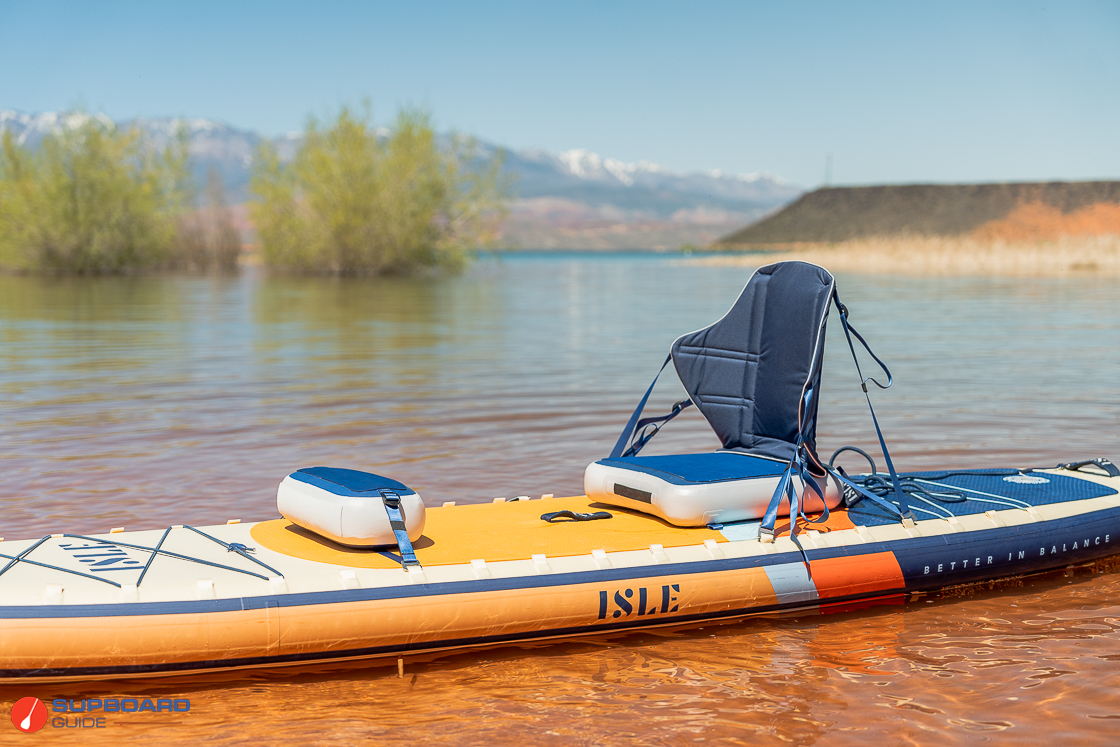
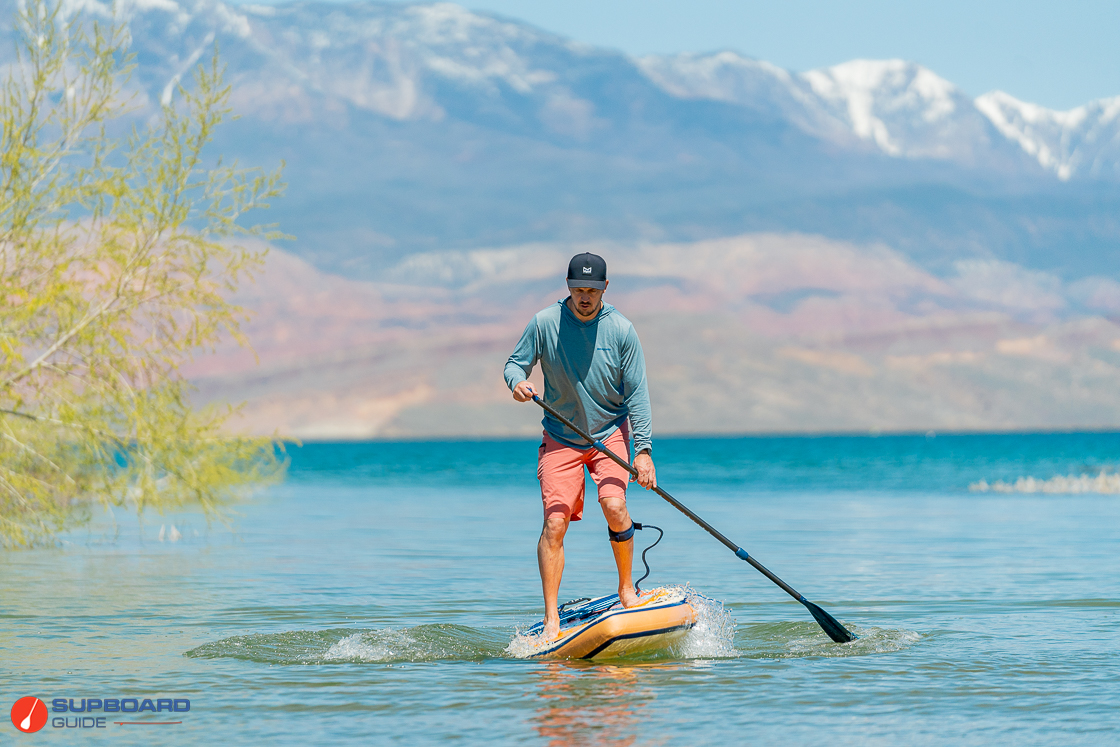
Overall Score: [9.6/10]
- Stability: 9.3/10
- Speed: 9.1/10
- Tracking: 9.2/10
- Maneuverability: 8.5/10
- Construction Quality: 9.6/10
- Features/Accessories: 9.7/10
Stability Rating: [9.3/10]
For an 11’6 x 32 touring board, the Explorer 3 is extraordinarily stable. The plan shape has been pushed pretty much to the absolute limit in terms of extracting maximum stability from the design. The maximum width extends right up to the very front of the deckpad, and then the nose, while pointed in standard touring board style, still holds its width a long way forward, to create maximum ‘shoulder area’ in the design. Likewise, the board holds its width a long way back towards the tail, which is broad and square, again to create maximum ‘hip area’.
The end result is an exceptionally stable platform for a 32” wide board, that anyone other than the very heaviest of paddlers should be able to move around on in comfort, and/or load up with plenty of cargo.
To put this into perspective; the reason it’s scored in the lower 9s is because there are plenty of boards out there with even greater stability – but they’re 33, 34 or 35” wide. And thus a whole lot less suited to longer distance paddling or higher speeds. A 32” wide board is never going to be the most stable platform. But in comparison to other 32” wide touring boards, the Explorer 3 is definitely right up there as a high scorer in this category.
Speed Test: 9.1/10
| Isle Explorer 3 | |
| Top Sprint Speed: | 5.45 MPH |
| Average Cruising Speed: | 4.6 MPH |
To obtain our speed test results, we use a Speed Coach Sup 2. This gives us accurate readings on how fast we are paddling and our current stroke rates. For the top sprint speed, we paddle as hard as we can for approximately 10-15 seconds and then record our average speed. For the casual test, we paddle at 35-40 strokes per minute for approximately 30-60 seconds and record the average speed.
It’s fairly common to follow a really high-scoring stability rating with a rather less impressive speed score. Those things that make a board stable all too often create drag, which inevitably takes its toll on the speed. However, the Isle Explorer 3 actually does fairly well in this department. That bullet-like plan shape is comfortably fast; it doesn’t feel like it’s pushing water when you’re paddling the board. And the light weight absolutely comes into play here; it’s always easier to make good speed on a lighter board.
So what we actually found was that, while not the fastest touring board on the market, the Explorer 3 has a very respectable cruising speed. And it can certainly hold its own against other 32” wide touring boards.
Stepping it up to find a maximum speed (we’re talking about a normal paddler going fairly hard out with the standard nylon-bladed paddle supplied, as opposed to how the board would fare with a world champion powering it with an $800 sprint paddle), we managed to crank it up nearly another mph, but this is where you do start to find a bit of bend and reverberation from the single skin construction.
The board naturally has a very slight degree of sag, as can be seen in the pictures (and discussed more in the board stiffness section), which starts to become a factor when you look for the higher speeds. Normally we’d expect to be able to gain at least a full extra 1 mph in sprint mode compared to cruise mode.
However, this isn’t a board designed to win sprint contests so it’s not really an issue. The main point that we do very much like is that the board definitely has a better-than-average cruise mode!
Tracking: 9.2/10


Good tracking is important in a board designed for paddling longer distances, and the Explorer 3 certainly doesn’t disappoint in this department. 11’6 is enough board length to deliver a decent amount of tracking in itself, but again the parallel-sided ‘bullet like’ plan shape of the design really adds to the directionality of the design – it cuts a straight and steady line through the water, and is very easy to hold on course. The rearward position of the single fin helps in this regard too.
Good tracking is of course also a function of paddle technique, and even more importantly, paddle position. However good your paddle technique may be, if you’re paddling a 36” wide board, your blade is in the water so far out from the centreline that each stroke becomes a turning stroke!
This is why board width plays such a big part in tracking – the narrower the board, the less this becomes a factor. 32” is the board width whereupon most paddlers are able to get their paddle blade vertically down into the water, rather than canted over, and it becomes easier to achieve proper paddling technique.
The very parallel sides of the Explorer 3 also naturally assist in generating good paddle technique, because the paddle blade has to follow that perfect line along the side, exactly matching the course of the board. This also plays a part in making the board track well, even for inexperienced paddlers.
Maneuverability: 8.5/10
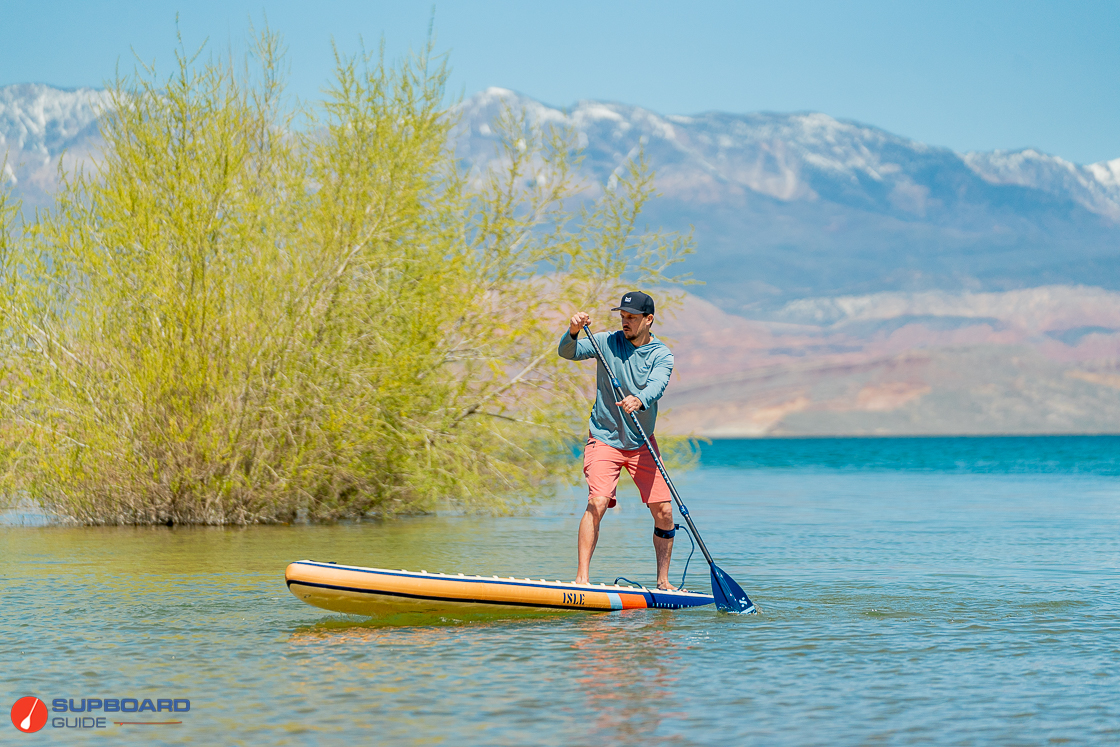

A good score in the tracking category almost invariably means a reduced one when it comes to maneuverability. A board can’t be directional and turny at the same time, right? Well, no it can’t. But, it can be light. Which the Isle Explorer 3 most certainly is. And a light board just feels that bit more throwabout.
Yes, it takes a few more strokes to turn the board around using standard paddle turning techniques, but the board certainly doesn’t feel resistant to the idea of turning.
If you’re up to more advanced turning techniques, having all that stability in the tail area makes it very easy and comfortable to step back and get the nose out of the water to supercharge those turns, and then the very square tail and rearward fin position really allow you to spin the board round in style.
So overall, while a touring board is never going to be the most throwabout design on the market, we were quite happy with the turning capabilities of this board in comparison to other touring designs.
Construction Quality: 9.6/10

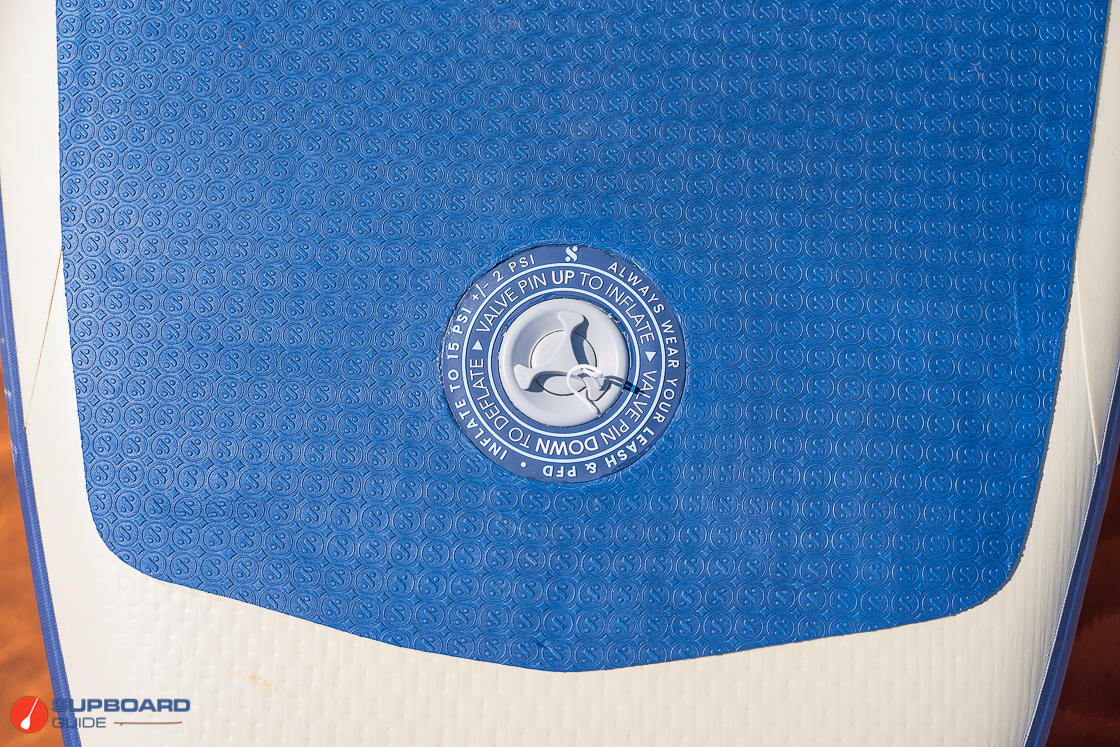
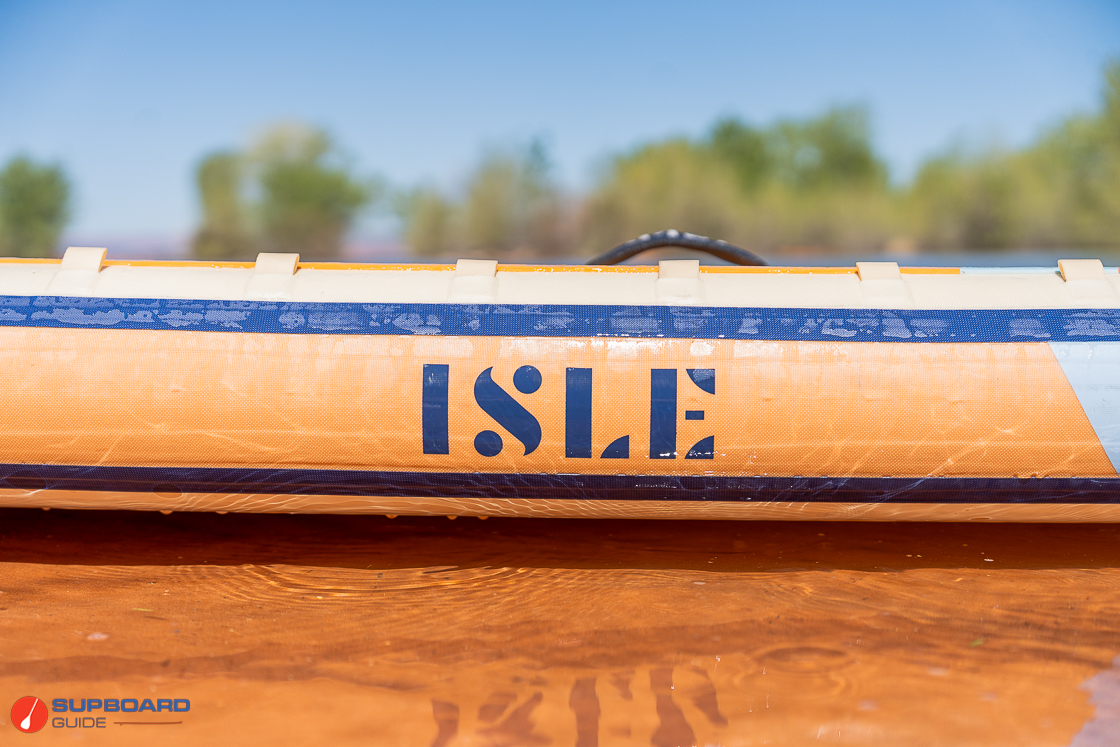

The main difference between the Isle Explorer 2 and this latest version is in the construction. Isle has moved from the fusion system ( 2 layers of PVC fused together during the fabric manufacturing process), to a single layer system, with the layer fused directly to the dropstitch.
Single layer construction is being revisited by an increasing number of brands in recent years, because of the significant weight-saving benefits that it offers. It originally lost favor because despite being light, single layer boards were just too flexy and flimsy.
However, leading manufacturers such as Isle are now using sophisticated stringer systems and other clever techniques to do away with these problems and bring single-skin back into the game. And what they’ve achieved here is a 5lb weight saving between the Explorer 2 and Explorer 3. That’s major!
The Explorer 3 also boasts welded seams. Many brands are moving to some sort of welded seam approach, but there are many different welding techniques out there, some most definitely better than others.
Isle have developed their own ‘Powerfuse’ welding construction method, which results in the two very noticeable raised lines along the board rail, underneath the outer rail tape. Isle are clearly very happy with what they have achieved with this technique, and have increased the length of their board warranty accordingly.
All up, the board feels very different to the previous generation of single-layer boards.
Indeed, the only major difference between the Explorer 3 and Isle’s flagship Explorer Pro range is that the Explorer 3 uses 4 PVC stringers instead of the ‘Infinity Fiber’ rail system used on the Pro boards, which adds to the cost but makes the board even stiffer. The PVC stringers on the Explorer can clearly be seen, running along the top and bottom of the rail on each side, almost all the way from the nose to the tail.
Overall, we’re extremely impressed that Isle has been able to create such a rigid board using single layer construction. The other single layer boards we’ve tested recently have been considerably less stiff than this.
Board Stiffness:

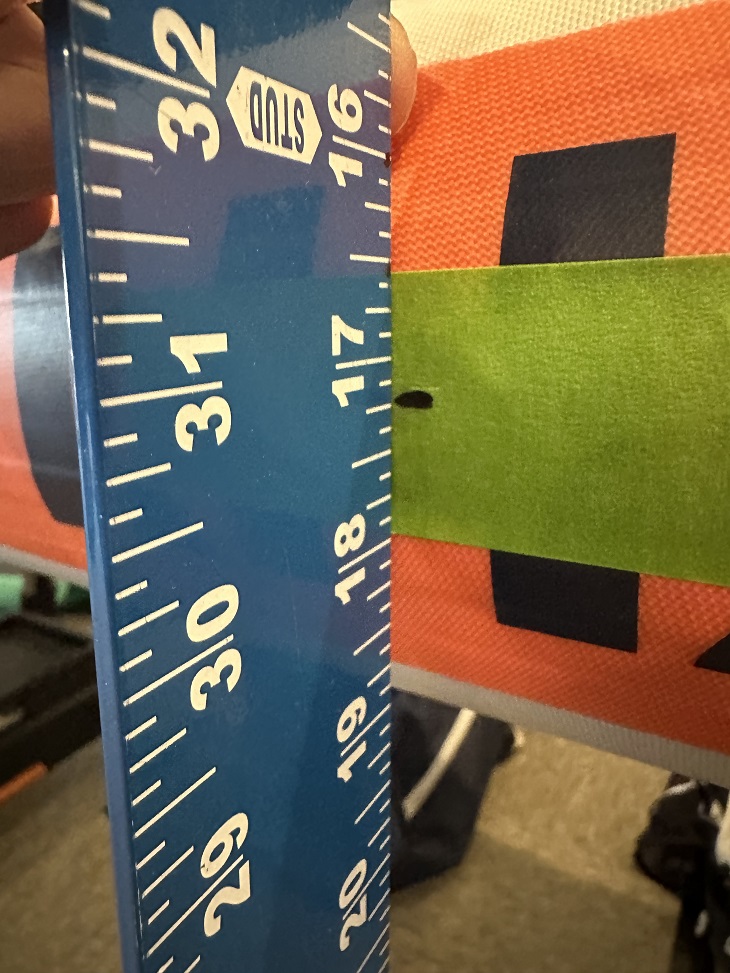
Stiffness Test: 1.25” Bend
The deflection of 1.25” is a fairly average result, in comparison with the many hundreds of other iSUPs we’ve measured over the years. However, that in itself is a very striking finding. Because the vast majority of those other boards featured Fusion or double-layer construction. Getting just 1.25” of deflection from a board with single layer construction is actually very impressive.
We’re more used to seeing 2-3” or more of deflection on single layer boards.
This really demonstrates how well the Isle stringer system and construction mechanism is working.
Certainly, on the water, the board does not feel noticeably flexy, until you really go for it with your paddling, whereupon it starts to become more noticeable in a way that you won’t find on double layer / fusion touring boards of similar dimensions.
To ascertain the rigidity of each board we review, we use our own specific laboratory bend test process. The board is inflated to its maximum recommended PSI and then placed across two sawhorses positioned exactly 7 feet apart. We then measure the distance from the middle of the board to the floor. Then, we place a 150 lb weight on the middle top of the SUP, and measure the distance to the floor again. The difference between the two measurements shows the deflection, or ‘sag’, that the board has experienced due to the added weight. We have been reviewing the stiffness of boards using this technique since 2021 and while it isn’t an exact replication of the weight distortion that occurs when a rider stands on a SUP board in the water, it still gives a very useful comparative tool in determining the stiffness of the board’s construction process.
Features/Accessory Review: [9.7/10]
Features:


One of the big changes on the latest generation of Isle boards is the Isle-Link system; 19 loops evenly spaced along each rail, for connecting your bungees, kayak seat, footrests, dry bags, fishing crates or whatever else you want to carry. (Isle offer all these as accessory options). It’s a great idea, and gives a huge amount of versatility to the platform.


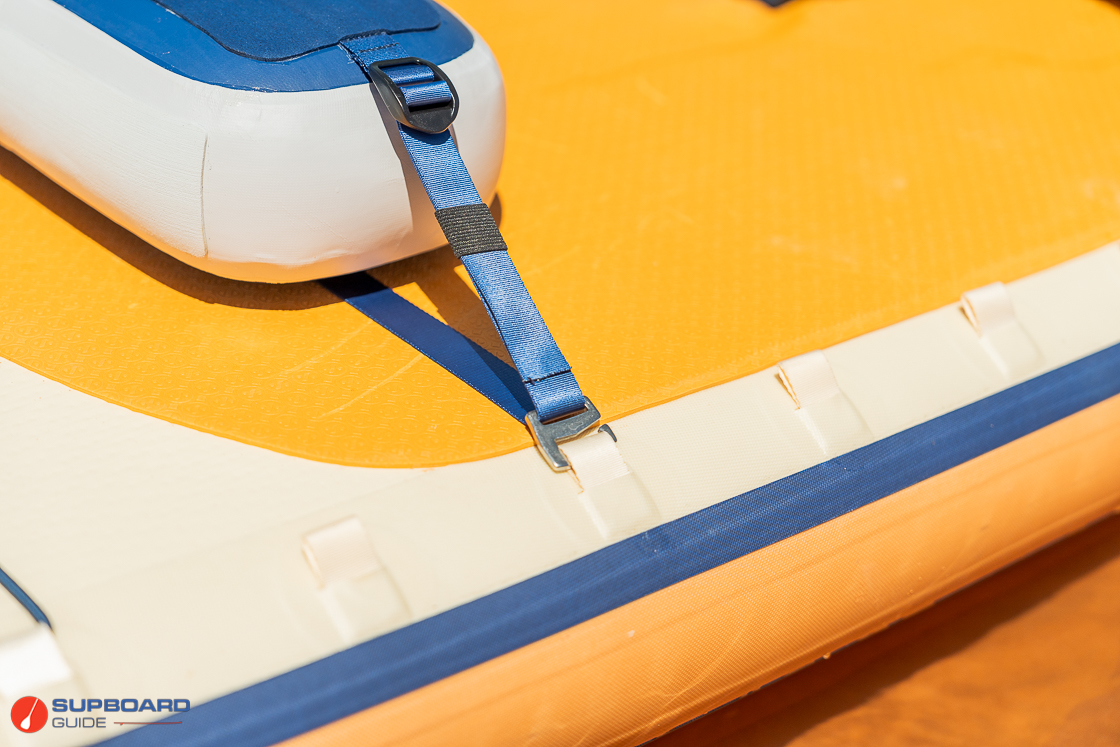

The board has a pair of paddle holder velcro straps on the right hand rail, allowing you to store the paddle well clear of the deckspace area.
The deckpad is around ¾ length, extending from the tail to the front of the standing area. It’s nicely textured, and comfortable underfoot. Unless you particularly need that rear bungee it’s nice to remove it and have the large expanse of completely uncluttered deck to be able to move around on. The deckpad doesn’t include any sort of raised pad in the tail but the inflation valve underfoot will tell you when you’ve walked back far enough to really power up those tail-sink turns!
The handle on the nose includes a screw thread for an action camera mount or some other accessory mount. Some brands include multiple action camera mounts on their boards, but Isle have preferred to keep the deck free of extraneous fittings, so they’ve kept it to just the one. If you do require further camera mounts it’s easy enough to use the stick-on ones.
On the underside, the Explorer 3 has shed the side fins featured on the Explorer 2. We’re quite happy with this; they weren’t really performing any useful function but added a bit of unnecessary weight, and also made the board harder to roll up. On which note, the Explorer 3 also features a split fin box, again to make it easier to roll the board up.

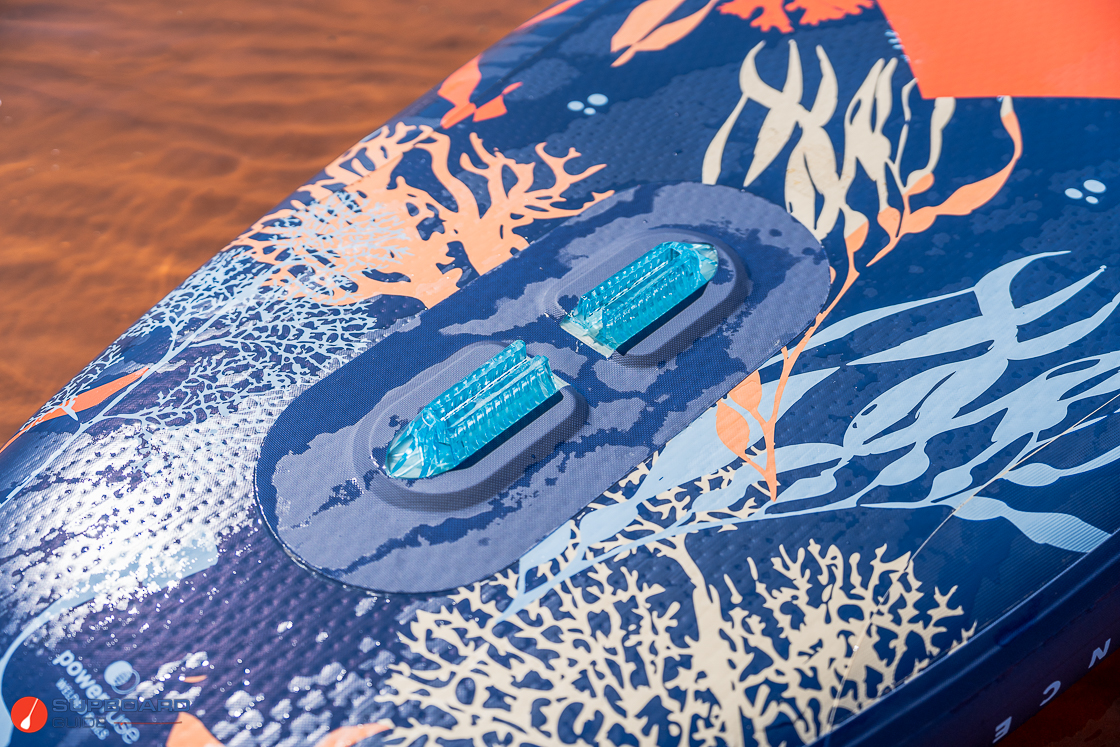
The single, centrally positioned Isle 9” touring fin clicks in without the requirement for a fin-bolt and screw, and comes with three different plug-in compression options for adjusting how easily the fin clicks in and out. The fin box is essentially a split US standard fin box, so other US-box compatible fins can be used. Note that the fin box is exactly the size of the 9” fin base though, so if you’re wanting to use a longer-based fin such as a weed fin, it may be too long for the box. Although the supplied fin doesn’t require a bolt and screw to fix it into position, one can be used if desired (and if you’re using a different fin to the one supplied you’d certainly want to do this).
We like that Isle has a carrying handle on the top of the nose, and also a steel towing eye on the underside of the nose. This sort of attention to detail is the mark of a quality brand.
Included Accessories:

The Isle Explorer 3 comes as standard with:
The 3 Series Wheelie backpack is spacious enough for the board and all the usual accessories. The bag has a hard base section so as to make it easy to open right up and pack all your goodies into. The backpack straps can be tucked away when not needed.
The Isle Remix Carbon 3-piece adjustable paddle has a carbon/fiberglass shaft and an 85” nylon blade. It converts easily from SUP to kayak mode by adding a second blade (sold separately). In SUP mode the adjustment range is 14”, catering for most paddler heights. We found the paddle to be light, pleasant and easy to use. Those wishing to extend their range further and make the most of the Explorer’s touring capabilities may prefer to upgrade to a paddle with a fiberglass/carbon blade.
The Totora double action hand pump has a removable base for easier storage.
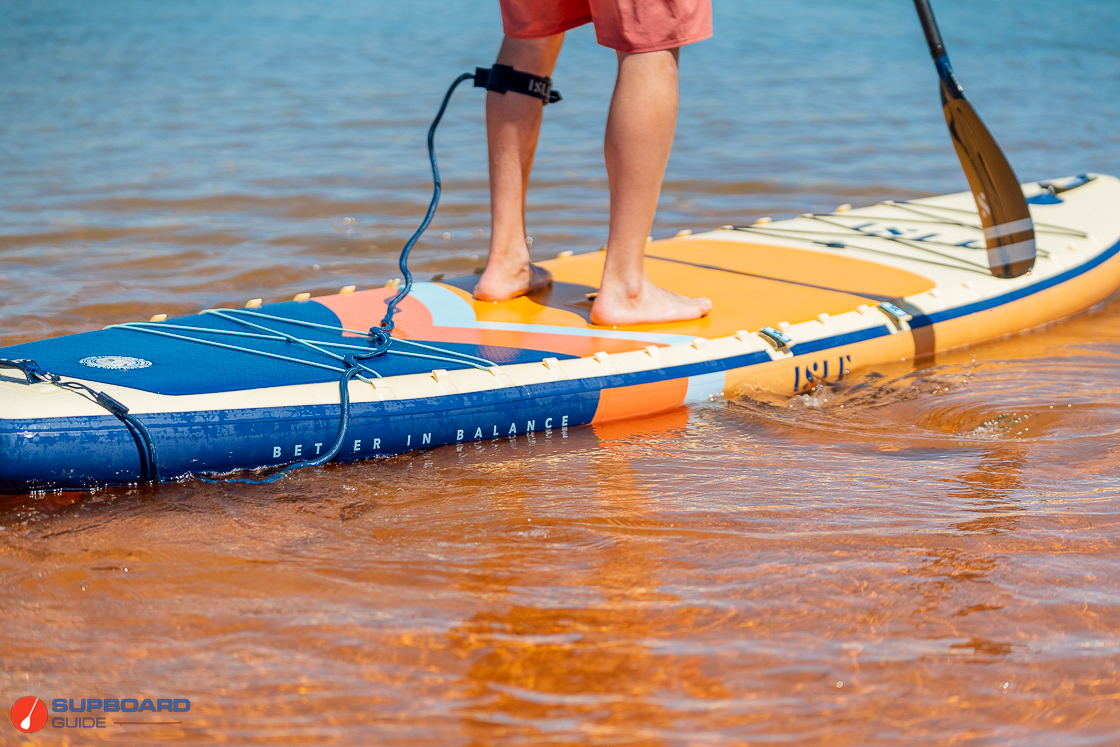
Summary Review of the Isle Explorer 3

As we said at the beginning of this review of the Explorer 3, Isle has taken an already proven touring design and made it even better – not by changing the shape, but by reducing the weight and enhancing the versatility.
We like what they’ve done.
Indeed, it’s been a bit of a revelation in just how much of a difference the weight reduction actually makes. The board cruises at a higher speed and feels more alive – but it still tracks just fine and certainly hasn’t lost anything in terms of stability and weight carrying ability.
So, while a 32” wide board is never going to have the speed and glide of a specialist 30” touring design, the Explorer 3 offers a lot more versatility. A specialist touring board isn’t usually considered as an ideal beginner board purchase, but the extreme stability that this board offers means that it can most certainly work as a first time board for average weight riders, who want a board that they can then progress straight on to developing their intermediate paddling skills and paddling further afield on.
The ability to convert it to kayak mode also adds further to that all round versatility. This could function just fine as a family board, for the kids to mess around on, friends to learn on, and Mum/Dad to use for fitness and longer distance paddling too.
All in all, it’s an excellent bit of kit, and we’re confident that we’re going to be seeing plenty of these out on the water this summer.
Happy paddling! We hope you enjoyed this review of the Isle Explorer 3. If you have any questions or comments please leave us a comment below!
SupBoardGuide
Latest posts by SupBoardGuide (see all)
- Hala Radito Whitewater iSUP Review – 2025 - June 27, 2025
- Hala Atcha 96 Whitewater iSUP Review – 2025 - June 16, 2025
- Thurso Surf Expedition 150 iSUP Review – 2025 - June 12, 2025






